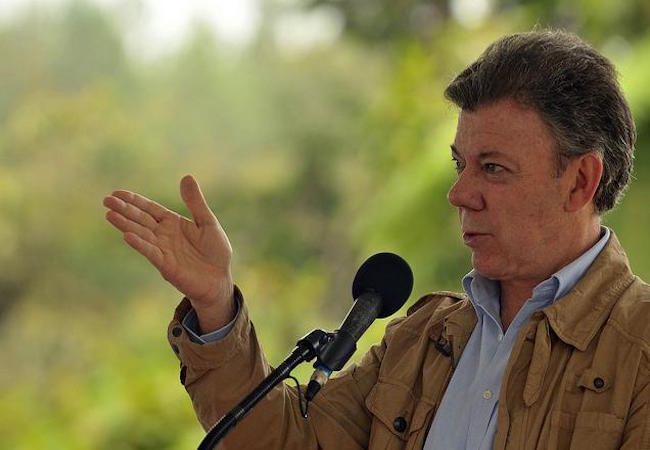Colombian government, FARC rebels sign historic ceasefire agreement

The Colombian government and FARC guerrilla group on Thursday signed a historic ceasefire deal, bringing the country’s half-century civil war closer to a definitive end.
Colombian President Juan Manuel Santos and top FARC commander Timoleon “Timochenko” Jimenez presided over the signing ceremony in Havana, Cuba, which was attended by world dignitaries, including Latin American heads of state and the secretary general of the United Nations (UN).
“Today is a historic day for Colombia after more than 50 years of deaths and confrontations,” said Santos. “This represents the end of the FARC as an armed group.” The agreement sets up mechanisms for the FARC to disarm and its transition to a political party or movement, although the disarmament process will not begin until a definitive peace treaty is signed.
“I don’t agree, and never will, with their political and economic vision for the country, but what we are acknowledging today is the possibility of disagreeing and looking at opposing view points without the need for violent confrontation,” Santos said.
“As head of state, I will defend their right to … continue their political struggle via legal means,” he said, adding “that is the essence of the democracy that we are welcoming” today.
Jimenez, the head of the FARC, stressed the agreement was not a capitulation of the group’s demands, but a negotiated settlement. The agreement, he said, “is not the surrender of the insurgency, but a product of serious dialogue between two forces in conflict for over half a century, with neither able to defeat the other.” Cuban President Raul Castro hailed the agreement as a victory for Colombia, and said it reinforced the concept of Latin America as a place of peace.
The agreement follows nearly four years of peace negotiations in Havana, which hosted the talks, and commits the Colombian government and rebels to set aside fighting and adopt peaceful, democratic means of resolving their disputes.
The head of the Colombian government delegation to the talks, Humberto de la Calle, signed on behalf of the government, while his FARC counterpart, Ivan Marquez, signed on behalf of the rebel group.
The agreement was also signed by the representatives of Cuba and Norway, Rodolfo Benitez and Dag Nylander, whose countries’ served as guarantors of the peace talks, and the presidents of Venezuela and Chile, Nicolas Maduro and Michelle Bachelet, whose countries assisted the talks as accompanying nations.
Benitez and Nylander presented the details of the agreement prior to the signing, including the creation of a tripartite mechanism to monitor its application, composed of the government, FARC and an international group in which the UN and the Community of Latin American and Caribbean States (CELAC) will play a key role.
As part of the disarmament process, which is to take no longer than 180 days, the rebels are to hand over their weapons to the UN, which all sides agreed will use them to build three monuments.
“Disarming is a technical, traceable and verifiable process,” Cuba’s Benitez said.
In his speech, Santos noted successive Colombian governments have over the past 30 years tried but failed to reach a peace agreement with the FARC.
Following up on that remark, Colombia’s Caracol news network interviewed Henry Acosta, a negotiator in previous peace efforts, most notably for the administration of hardline former president Alvaro Uribe.
Asked why the attempt at brokering peace succeeded, Acosta said, “the big difference is that the only thing president Uribe wanted was the FARC’s surrender.”
In contrast, said Acosta, “President Santos clearly said ‘this is a negotiating process,’ … that’s why the correct term (for this agreement) is not surrendering arms, but laying down arms.”
During the ceremony, Santos presented Timochenko with a pen made out of a large caliber bullet, the kind state forces used against the rebels, inscribed with the words: “Bullets wrote our past. Education, our future.”
Meanwhile, in Bogota, residents marked the ceasefire and end to hostilities in colorful ways, including placing a funeral wreath at central Bolivar Square to symbolize the end of the conflict, with a banner that read “Goodbye to the war.”
Newspaper headlines also announced “The Final Day of the War.”
According to Latin American news network Telesur, Latin America’s longest-running civil war claimed 220,000 deaths up to 2012, left 25,000 missing and displaced 5.7 million people.




